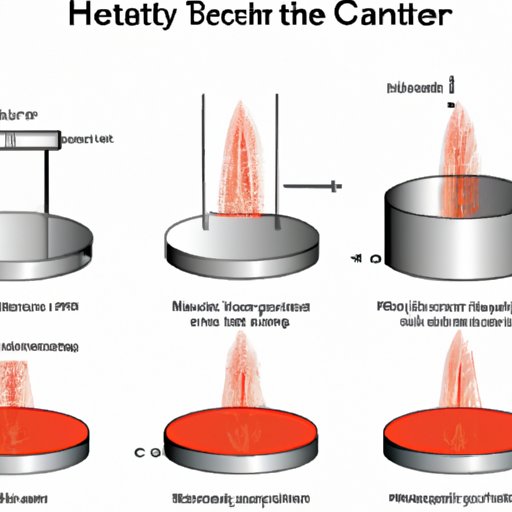
Introduction
Specific heat is an important concept that plays a crucial role in thermodynamics, materials science, chemistry, and other fields. It is a measure of a particular material’s ability to hold heat energy, which makes it a fundamental tool to understand how energy is transferred between material objects. In this article, we’ll explore everything you need to know about calculating specific heat, from the science behind it to practical tips and methods for mastering it.
Understanding the Science Behind Specific Heat: A Step-by-Step Guide
To understand specific heat, we need first to define it. Specific heat is the amount of heat energy required to increase the temperature of a unit mass (typically in grams) of a substance by one degree Celsius. It is denoted by the symbol C. The formula for specific heat is as follows:
C = Q/m∆T
Where Q is the heat energy (in Joules), m is the mass of the substance (in grams), and ∆T is the change in temperature.
To better understand the concept of specific heat, let’s take an example. Let’s say we want to raise the temperature of 100 grams of water from 20°C to 30°C. The specific heat of water is 4.18 J/g°C. We can calculate the amount of energy required to do so using the specific heat formula.
C = 4.18 J/g°C
m = 100 g
∆T = 30°C – 20°C = 10°C
By plugging in these values, we can calculate the amount of energy required:
Q = C x m x ∆T
Q = 4.18 x 100 x 10
Q = 4180 Joules
This means we need 4180 Joules of energy to raise the temperature of 100 grams of water from 20°C to 30°C.
Calculating Specific Heat Coefficients for Different Materials
In addition to understanding specific heat, it’s also important to know how to calculate specific heat coefficients for different materials. Specific heat capacity is the amount of heat energy required to raise the temperature of one unit of mass of a substance by one degree Celsius, while the molar specific heat is the amount of heat energy needed to raise the temperature of one mole of a substance.
The specific heat values for different materials can vary widely. For example, water has a specific heat capacity of 4.18 J/g°C, while iron has a specific heat capacity of 0.45 J/g°C. Other common materials and their specific heat values include:
- Aluminum: 0.91 J/g°C
- Copper: 0.39 J/g°C
- Gold: 0.13 J/g°C
- Lead: 0.13 J/g°C
- Silver: 0.24 J/g°C
Once you know the specific heat capacity of a material, you can calculate the specific heat coefficient using the formula discussed earlier. Here’s a step-by-step guide:
- Measure the mass of the substance in grams
- Measure the initial temperature of the substance
- Apply heat to the substance and measure the temperature increase
- Calculate the amount of heat energy required to achieve that temperature increase using the specific heat formula (Q = C x m x ∆T)
- Calculate the specific heat coefficient using the formula (C = Q/m∆T)
Mastering the Art of Specific Heat Calculation with These Simple Tips
Even though the formula for specific heat is relatively simple, there are common mistakes that people make when calculating it. To avoid these mistakes, here are some tips:
- Make sure to use the correct units (Joules for energy, grams for mass, and Celsius for temperature)
- Always double-check your calculations to ensure accuracy
- Use a digital thermometer or other precise measuring instruments to ensure accuracy in measurements
- Ensure that you use the correct specific heat value for the material you are working with
If you encounter problems when calculating specific heat, here are some troubleshooting tips:
- Check your calculations to ensure that you have the correct values for mass, temperature change, and specific heat
- Review your measurements to ensure accuracy
- Double-check that you are using the correct formula

From Theory to Practice: A Practical Guide to Calculating Specific Heat
While understanding the theory behind specific heat is important, it’s also essential to know how to use this knowledge in real-world scenarios. Here are some practical examples:
- Determining how long it will take to heat up or cool down a given volume of a material
- Calculating the energy required to cook or bake food
- Designing and building heating and cooling systems for homes and buildings
- Calculating the amount of energy required to melt ice or boil water
Here’s a practice problem to help put this in perspective. Let’s say you need to determine how much energy is required to melt 50 grams of ice at -20°C and raise the temperature to 25°C. The specific heat of ice is 2.09 J/g°C, and the heat of fusion for ice is 333 J/g. Here are the steps to follow:
- Calculate the energy required to melt the ice using the heat of fusion formula (Q = m x Hf)
- Q = 50 x 333 J/g
- Q = 16650 Joules
- Calculate the energy required to raise the temperature of the melted ice (water) using the specific heat formula we discussed earlier (Q = C x m x ∆T)
- C = 4.18 J/g°C (specific heat of water)
- m = 50 g
- ∆T = 25°C – 0°C = 25°C
- Q = 4.18 x 50 x 25
- Q = 5236 Joules
- Add the two values to find the total energy required: 16650 + 5236 = 21886 Joules
Why Specific Heat Calculation Matters and How to Do It Like a Pro
Specific heat calculation is vital in various fields, including engineering, chemistry, thermodynamics, and material science. In engineering, it’s used to design heating and cooling systems, while in material science, it’s used to understand heat transfer and storage. In chemistry, it’s used to understand chemical reactions, while in thermodynamics, it’s used to study energy transfer. Precise and accurate specific heat calculations are essential for efficient and effective design, testing, and study. Here are some tips to help you become a pro at calculating specific heat:
- Ensure that you have a thorough understanding of the principles of specific heat, including the formulas and units used
- Practice regularly by working through example problems and exercises
- Use precision equipment such as digital thermometers when measuring temperature
- Verify your answers by performing the calculation using a different method or checking your work for accuracy
Exploring the Different Methods of Calculating Specific Heat in Chemistry
There are various methods of calculating specific heat in chemistry, including constant-pressure calorimetry, bomb calorimetry, differential scanning calorimetry, and others. Constant-pressure calorimetry involves measuring the change in enthalpy of a reaction using a calorimeter, while bomb calorimetry involves measuring the change in energy of a combustion reaction. Differential scanning calorimetry measures the heat flow required to increase the temperature of a substance in a controlled environment and is often used in material science. Each method has advantages and disadvantages depending on the application. For example, constant-pressure calorimetry may not be ideal for reactions that produce gases or volatile compounds, while differential scanning calorimetry may not be effective for practical or industrial applications.
How to Solve Specific Heat Problems for Engineering and Physics Students
Engineering and physics students often encounter specific heat problems in their coursework. These problems can be challenging but are manageable with a good understanding of the principles of specific heat. Here’s an example:
A 10.0-gram sample of copper is heated from 25°C to 35°C. Calculate the amount of energy required.
Here’s how to approach the problem:
- Calculate the change in temperature (∆T) = 35°C – 25°C = 10°C
- Use the specific heat formula (Q = C x m x ∆T) to calculate the energy required
- Use the specific heat of copper, which is 0.39 J/g°C
- Calculate C x m: 0.39 J/g°C x 10.0 g = 3.9 J/°C
- Calculate Q: 3.9 J/°C x 10°C = 39 J
Therefore, we need 39 Joules of energy to heat 10 grams of copper from 25°C to 35°C.
Conclusion
In summary, calculating specific heat is an essential skill in thermodynamics, material science, chemistry, and engineering. Understanding the science behind it, knowing how to calculate specific heat coefficients for different materials, mastering the art of specific heat calculation, and exploring different methods of calculating specific heat are all important components of learning this fundamental concept. It’s a skill that’s worth investing time and effort into, given how critical it is in many fields.





